Contribution of Smart Cities to the Energy Sustainability of the Binomial between City and Country
Abstract
Featured Application
Abstract
1. Introduction
2. Concepts Review
2.1. Energy Sustainability
2.2. Smart City Model
3. Smart city Strategy to Energy Sustainability
- Guarantee the efficacy of the energy service in cities, based on the safety and quality of the electricity supply (meaning no interruptions in service) in order to provide services (mobility, lighting, heating, cooling, health, etc.) as demanded by the urban population.
- Manage efficiently the resources needed to provide the energy service to the city: energy resources, economic resources, and the existing infrastructures.
4. Urban Population and Urban PV Generation vs. Energy Sustainability
4.1. Energy Trilemma Index and Urban Population in the Period 2014–2017
4.2. Photovoltaic Generation in Cities and ETI 2017
5. Conclusions
Author Contributions
Funding
Conflicts of Interest
References
- World Commission on Environment and Development. Report of the World Commission on Environment and Development: Our Common Future (The Brundtland Report). Med. Confl. Surviv. 1987, 4, 300. [Google Scholar] [CrossRef]
- IEA (International Energy Agency). World Energy Outlook-2018; OECD/IEA: Paris, France, 2018. [Google Scholar]
- United Nations: Department of Social and Economic Affairs. World Population Prospects: The 2012 Revision, Key Findings and Advance Tables; Working Paper No. ESA/P/WP.227; United Nations: New York, NY, USA, 2013. [Google Scholar]
- World Bank. World Development Indicators Data Catalog. Available online: https://datacatalog.worldbank.org/dataset/world-development-indicators (accessed on 21 June 2019).
- European Climate Foundation. Roadmap 2050: A Practical Guide to a Prosperous, Low-Carbon Europe 2010:3. Available online: https://www.roadmap2050.eu/attachments/files/Roadmap2050-AllData-MinimalSize.pdf (accessed on 21 June 2019).
- IRENA Renewable Energy in Cities, International Renewable Energy Agency, Abu Dhabi. Available online: www.irena.org/publications (accessed on 21 June 2019).
- IDC; Anteverti. Hoja de Ruta Para la Smart City. Available online: http://www.ctecno.cat/wp-content/uploads/2012/03/Hoja-de-Ruta-Smart-Cities-def..pdf (accessed on 21 June 2019).
- Angelidou, M. Smart city policies: A spatial approach. Cities 2014, 41, S3–S11. [Google Scholar] [CrossRef]
- Espinoza-Arias, P.; Poveda-Villalón, M.; García-Castro, R.; Corcho, O. Ontological Representation of Smart City Data: From Devices to Cities. Appl. Sci. 2018, 9, 32. [Google Scholar] [CrossRef]
- Lund, H.; Østergaard, P.A.; Connolly, D.; Mathiesen, B.V. Smart energy and smart energy systems. Energy 2017, 137, 556–565. [Google Scholar] [CrossRef]
- World Energy Council (WEC) and Oliver Wyman. Energy Trilemma Index 2013. Available online: https://www.worldenergy.org/wp-content/uploads/2013/09/2013-Energy-Sustainability-Index-VOL-2.pdf (accessed on 21 June 2019).
- World Energy Council (WEC) and Oliver Wyman. Energy Trilemma Index 2017. Available online: https://www.worldenergy.org/wp-content/uploads/2017/11/Energy-Trilemma-Index-2017-Report.pdf (accessed on 21 June 2019).
- World Energy Council (WEC) and Oliver Wyman. Pathway Calculator. 2017. Available online: https://trilemma.worldenergy.org/#!/pathway-calculator (accessed on 28 May 2019).
- Doran, G.T. There’s a S.M.A.R.T. way to write management’s goals and objectives. Manag. Rev. 1981, 70, 35–36. [Google Scholar]
- Lee, J.; Lee, H. Developing and validating a citizen-centric typology for smart city services. Gov. Inf. Q. 2014, 31, S93–S105. [Google Scholar] [CrossRef]
- Caragliu, A.; Del Bo, C.; Nijkamp, P. Smart Cities in Europe. J. Urban Technol. 2011, 18, 65–82. [Google Scholar] [CrossRef]
- Oliviera Fernandes, E.; Meeus, L.; Leal, V.; Azevedo, I.; Delarue, E.; Glachant, J.-M. Smart Cities Initiative: How to Foster a Quick Transition Towards Local Sustainable Energy Systems; European University Institute: Firenze, Italy, 2011. [Google Scholar]
- Batty, M.; Axhausen, K.W.; Giannotti, F.; Pozdnoukhov a Bazzani a Wachowicz, M.; Ouzounis, G.; Portugali, Y. Smart cities of the future. Eur. Phys. J. Spec. Top 2012, 214, 481–518. [Google Scholar] [CrossRef]
- Kramers, A.; Höjer, M.; Lövehagen, N.; Wangel, J. Smart sustainable cities—Exploring {ICT} solutions for reduced energy use in cities. Environ. Model. Softw. 2014, 56, 52–62. [Google Scholar] [CrossRef]
- Caragliu, A.; DBo, C.; Kourtit, K.; Nijkamp, P. Smart Cities; Elsevier: Amsterdam, The Netherlands, 2015. [Google Scholar] [CrossRef]
- Gonz, L. El Papel De Las Normas en Las Ciudades Inteligentes. 2014. Available online: https://www.esmartcity.es/biblioteca/informe-el-papel-de-las-normas-en-las-ciudades-inteligentes (accessed on 21 June 2019).
- Manville, C.; Cochrane, G.; Cave, J.; Millard, J.; Pederson, J.K.; Thaarup, R.K.; Liebe, A.; Wissner, M.; Massink, R.; Kotterink, B. Mapping Smart Cities in the EU; European Parliament: Brussels, Belgium, 2014; Volume 200. [Google Scholar] [CrossRef]
- Achaerandio, R.; Galloti, G.; Curto, J.; Bigliani, R.; Maldonado, F. Análisis de las Ciudades Inteligentes en España. 2011. Available online: https://www.esmartcity.es/biblioteca/analisis-de-idc-de-las-ciudades-inteligentes-en-espana (accessed on 21 June 2019).
- Drohojowska, H. San Francisco Style, Art-Deco Elements Inform a Smart City Residence + Interior-Design by Arnold, Val. Archit. Dig. 1991, 48, 114–121. [Google Scholar]
- Shetty, V. A tale of smart cities. Commun. Int. 1997, 24, 16–18. [Google Scholar]
- Neirotti, P.; De Marco, A.; Cagliano, A.C.; Mangano, G.; Scorrano, F. Current trends in Smart City initiatives: Some stylised facts. Cities 2014, 38, 25–36. [Google Scholar] [CrossRef]
- Albino, V.; Berardi, U.; Dangelico, R.M. Smart Cities: Definitions, Dimensions, Performance, and Initiatives. J. Urban Technol. 2015, 22, 3–21. [Google Scholar] [CrossRef]
- Angelidou, M. Smart cities: A conjuncture of four forces. Cities 2015, 47, 95–106. [Google Scholar] [CrossRef]
- Studies, M. Smart Cities Ranking of European Medium-Sized Cities; Vienna University of Technology: Vienna, Austria, 2007; Volume 16, pp. 13–18. [Google Scholar]
- Lazaroiu, G.C.; Roscia, M. Definition methodology for the smart cities model. Energy 2012, 47, 326–332. [Google Scholar] [CrossRef]
- Mattoni, B.; Gugliermetti, F.; Bisegna, F. A multilevel method to assess and design the renovation and integration of Smart Cities. Sustain. Cities Soc. 2015, 15, 105–119. [Google Scholar] [CrossRef]
- Ben Letaifa, S. How to strategize smart cities: Revealing the SMART model. J. Bus. Res. 2015, 68, 1414–1419. [Google Scholar] [CrossRef]
- Lee, J.H.; Hancock, M.G.; Hu, M.-C. Towards an effective framework for building smart cities: Lessons from Seoul and San Francisco. Technol. Forecast. Soc. Chang. 2013, 89, 80–99. [Google Scholar] [CrossRef]
- Bakici, T.; Almirall, E.; Wareham, J. A Smart City Initiative: The Case of Barcelona. J. Knowl. Econ. 2013, 4, 135–148. [Google Scholar] [CrossRef]
- Lee, J.H.; Phaal, R.; Lee, S.-H. An integrated service-device-technology roadmap for smart city development. Technol. Forecast. Soc. Chang. 2013, 80, 286–306. [Google Scholar] [CrossRef]
- European Commission. A Resource-Efficient Europe—Flagship Initiative Under the Europe 2020 Strategy; European Commission: Brussels, Belgium, 2011. [Google Scholar]
- European Commission. Smart Cities and Communities—European Innovation Partnership; European Commission: Brussels, Belgium, 2012. [Google Scholar]
- Ametic. Smart Cities 2013. Available online: https://www.hr.com/en/communities/2012-quality-of-living-worldwide-city-rankings-%E2%80%93-m_haderw3e.html (accessed on 21 June 2019).
- Harrison, C.; Donnelly, I.A. A Theory of Smart Cities. In Proceedings of the 55th Annual Meeting of the International Society for the Systems Sciences, Houcheng, UK, 17–22 July 2011. [Google Scholar]
- Sanchez, L.; Muñoz, L.; Galache, J.A.; Sotres, P.; Santana, J.R.; Gutierrez, V.; Ramdhany, R.; Gluhak, A.; Krco, S.; Theodoridis, E.; et al. SmartSantander: IoT experimentation over a smart city testbed. Comput. Netw. 2014, 61, 217–238. [Google Scholar] [CrossRef]
- Mercer. 2012 Quality Of Living Worldwide City Rankings: Survey; International HR Adviser: Sutton, UK, 2012; pp. 33–36. [Google Scholar]
- Paroutis, S.; Bennett, M.; Heracleous, L. A strategic view on smart city technology: The case of IBM Smarter Cities during a recession. Technol. Forecast. Soc. Chang. 2013, 89, 262–272. [Google Scholar] [CrossRef]
- Talari, S.; Shafie-Khah, M.; Siano, P.; Loia, V.; Tommasetti, A.; Catalão, J.P.S. A review of smart cities based on the internet of things concept. Energies 2017, 10, 421. [Google Scholar] [CrossRef]
- Mahapatra, C.; Moharana, A.K.; Leung, V.C.M. Energy management in smart cities based on internet of things: Peak demand reduction and energy savings. Sensors 2017, 17, 2812. [Google Scholar] [CrossRef] [PubMed]
- Hilty, L.M.; Aebischer, B.; Rizzoli, A.E. Modeling and evaluating the sustainability of smart solutions. Environ. Model. Softw. 2014, 56, 1–5. [Google Scholar] [CrossRef]
- European Commission. Energy Technologies and Innovation; European Commission: Brussels, Belgium, 2013. [Google Scholar]
- Höjer, M.; Wangel, J. Smart Sustainable Cities Definition and Challenges. ICT Innov. Sustain. 2014, 333–349. [Google Scholar] [CrossRef]
- Lund, H.; Werner, S.; Wiltshire, R.; Svendsen, S.; Thorsen, J.E.; Hvelplund, F.; Mathiesen, B.V. 4th Generation District Heating (4GDH): Integrating smart thermal grids into future sustainable energy systems. Energy 2014, 68, 1–11. [Google Scholar] [CrossRef]
- IRENA. Power System Flexibility for the Energy Transition, International Renewable Energy Agency, Abu Dhabi. 2018. Available online: www.irena.org/publications (accessed on 21 June 2019).
- Siano, P. Demand response and smart grids—A survey. Renew. Sustain. Energy Rev. 2014, 30, 461–478. [Google Scholar] [CrossRef]
- Yuan, J.; Shen, J.; Pan, L.; Zhao, C.; Kang, J. Smart grids in China. Renew. Sustain. Energy Rev. 2014, 37, 896–906. [Google Scholar] [CrossRef]
- Solomon, B.D.; Krishna, K. The coming sustainable energy transition: History, strategies, and outlook. Energy Policy 2011, 39, 7422–7431. [Google Scholar] [CrossRef]
- World Energy Council (WEC). Smart Grids: Best Practice Fundamentals for a Modern Energy System; WEC: London, UK, 2012; ISBN 9780946121175. Available online: https://www.worldenergy.org/wp-content/uploads/2012/10/PUB_Smart_grids_best_practice_fundamentals_for_a_modern_energy_system_2012_WEC.pdf (accessed on 21 June 2019).
- Dada, J.O. Towards understanding the benefits and challenges of Smart/Micro-Grid for electricity supply system in Nigeria. Renew. Sustain. Energy Rev. 2014, 38, 1003–1014. [Google Scholar] [CrossRef]
- Clastres, C. Smart grids: Another step towards competition, energy security and climate change objectives. Energy Policy 2011, 39, 5399–5408. [Google Scholar] [CrossRef]
- Lund, P.D.; Mikkola, J.; Ypyä, J. Smart energy system design for large clean power schemes in urban areas. J. Clean. Prod. 2014, 103, 437–445. [Google Scholar] [CrossRef]
- Ruiz-Romero, S.; Colmenar-Santos, A.; Mur-Pérez, F.; López-Rey, Á. Integration of distributed generation in the power distribution network: The need for smart grid control systems, communication and equipment for a smart city—Use cases. Renew. Sustain. Energy Rev. 2014, 38, 223–234. [Google Scholar] [CrossRef]
- Gaiser, K.; Stroeve, P. The impact of scheduling appliances and rate structure on bill savings for net-zero energy communities: Application to West Village. Appl. Energy 2014, 113, 1586–1595. [Google Scholar] [CrossRef]
- Ellabban, O.; Abu-Rub, H. Smart grid customers’ acceptance and engagement: An overview. Renew. Sustain. Energy Rev. 2016, 65, 1285–1298. [Google Scholar] [CrossRef]
- Mwasilu, F.; Justo, J.J.; Kim, E.-K.; Do, T.D.; Jung, J.-W. Electric vehicles and smart grid interaction: A review on vehicle to grid and renewable energy sources integration. Renew. Sustain. Energy Rev. 2014, 34, 501–516. [Google Scholar] [CrossRef]
- Uribe-Pérez, N.; Hernández, L.; de la Vega, D.; Angulo, I. State of the Art and Trends Review of Smart Metering in Electricity Grids. Appl. Sci. 2016, 6, 68. [Google Scholar] [CrossRef]
- Goulden, M.; Bedwell, B.; Rennick-Egglestone, S.; Rodden, T.; Spence, A. Smart grids, smart users? the role of the user in demand side management. Energy Res. Soc. Sci. 2014, 2, 21–29. [Google Scholar] [CrossRef]
- Eid, C.; Koliou, E.; Valles, M.; Reneses, J.; Hakvoort, R. Time-based pricing and electricity demand response: Existing barriers and next steps. Util. Policy 2016, 40, 15–25. [Google Scholar] [CrossRef]
- Ackermann, T.; Andersson, G.; Söder, L. Distributed generation: A definition. Electr. Power Syst. Res. 2001, 57, 195–204. [Google Scholar] [CrossRef]
- Chen, J.; Jain, R.K.; Taylor, J.E. Block Configuration Modeling: A novel simulation model to emulate building occupant peer networks and their impact on building energy consumption. Appl. Energy 2013, 105, 358–368. [Google Scholar] [CrossRef]
- GhaffarianHoseini, A.; Dahlan, N.D.; Berardi, U.; GhaffarianHoseini, A.; Makaremi, N.; GhaffarianHoseini, M. Sustainable energy performances of green buildings: A review of current theories, implementations and challenges. Renew. Sustain. Energy Rev. 2013, 25, 1–17. [Google Scholar] [CrossRef]
- GhaffarianHoseini, A.; Dahlan, N.D.; Berardi, U.; GhaffarianHoseini, A.; Makaremi, N. The essence of future smart houses: From embedding {ICT} to adapting to sustainability principles. Renew. Sustain. Energy Rev. 2013, 24, 593–607. [Google Scholar] [CrossRef]
- IRENA. Innovation Landscape: Aggregators, International Renewable Energy Agency, Abu Dhabi. 2019. Available online: www.irena.org/publications (accessed on 21 June 2019).
- Villa-Arrieta, M.; Sumper, A. Economic evaluation of Nearly Zero Energy Cities. Appl. Energy 2019, 237, 404–416. [Google Scholar] [CrossRef]
- Villa-Arrieta, M.; Sumper, A. A model for an economic evaluation of energy systems using TRNSYS. Appl. Energy 2018, 215, 765–777. [Google Scholar] [CrossRef]
- OECD/IEA; IRENA. Perspectives for the Energy Transition: Investment Needs for a Low-Carbon Energy System, Abu Dhabi. 2019. Available online: www.irena.org/publications (accessed on 21 June 2019).
- World Energy Council (WEC) and Oliver Wyman. Energy Trilemma Index 2014. Available online: https://www.worldenergy.org/publications/2014/world-energy-trilemma-2014-time-to-get-real-the-myths-and-realities-of-financing-energy-systems/ (accessed on 21 June 2019).
- World Energy Council (WEC) and Oliver Wyman. Energy Trilemma Index 2015. Available online: https://www.worldenergy.org/publications/2015/2015-energy-trilemma-index-benchmarking-the-sustainability-of-national-energy-systems-2/ (accessed on 21 June 2019).
- World Energy Council (WEC) and Oliver Wyman. Energy Trilemma Index 2016. Available online: https://www.worldenergy.org/publications/2016/2016-energy-trilemma-index-benchmarking-the-sustainability-of-national-energy-systems/ (accessed on 21 June 2019).
- Check, R.; Space-based, P.S.; Percent, K.; Shingles, E. The Future of Solar Energy; MIT Energy Initiative: Cambridge, MA, USA, 2015; pp. 3–6. [Google Scholar]
- IRENA. Renewable Energy Capacity Statistics 2019, International Renewable Energy Agency, Abu Dhabi. 2019. Available online: www.irena.org/publications (accessed on 21 June 2019).
- International Energy Agency (IEA). Renewables 2018. Market Analysis and Forecast from 2018 to 2023. 2019. Available online: https://www.iea.org/renewables2018/power/ (accessed on 13 June 2019).
- International Renewable Energy Agency. Renewable Energy Benefits Leveraging Local Capacity for Solar Pv, Abu Dhabi. 2019. Available online: www.irena.org/publications (accessed on 21 June 2019).
- 100 US Cities Are Committed to 100 Percent Clean, Renewable Energy|Sierra Club 2018. Available online: https://www.sierraclub.org/press-releases/2019/03/100-us-cities-are-committed-100-percent-clean-renewable-energy (accessed on 12 June 2019).
- UK100 2019. Available online: https://www.uk100.org/ (accessed on 12 June 2019).
- Ram, M.; Dmitrii, B.; Arman, A.; Solomon, O.; Ashish, G.; Michael, C.; Christian, B. Global Energy System Based on 100% Renewable Energy Power Sector; Lappeenranta University of Technology and Energy Watch Group: Lappeenranta, Finland; Berlin, Germany, 2017. [Google Scholar]
- Couture, T.D.; Leidreiter, A. How to Achieve 100% Renewable Energy; The World Future Council: Hamburg, Germany, 2014. [Google Scholar]
- CDP. Home—CDP 2019. Available online: https://www.cdp.net/en (accessed on 19 June 2019).
- Agencia de Energía de Barcelona. ¿Cuánta Energía Puedes Generar? 2016. Available online: http://energia.barcelona/es/cuanta-energia-puedes-generar (accessed on 20 March 2018).
- Agencia de Energía de Barcelona. Mapa de Recursos d ’ Energia Renovable de Barcelona. 2016. Available online: http://energia.barcelona/ca/quanta-energia-pots-generar (accessed on 20 March 2018).
- ESMAP; SOLARGIS; WB; IFC. Global Solar Atlas. Glob Sol Atlas 2019:1. Available online: https://globalsolaratlas.info/?c=32.651516,51.678658,11&s=32.65139,51.67917&m=sg:ghi (accessed on 22 May 2019).
- (ISE) FI for SES. Photovoltaics Report; Fraunhofer ISE: Freiburg, Germany, 2016. [Google Scholar]
- U.S. Energy Information Administration. International Energy Statistics n.d. Available online: https://www.eia.gov/beta/international/data/browser/#/?c=4100000002000060000000000000g000200000000000000001&vs=INTL.44-1-AFRC-QBTU.A&vo=0&v=H&start=1980&end=2016 (accessed on 21 June 2019).
- Ecometrica. Electricity-specific emission factors for grid electricity. Ecometrica 2011, 1–22. [Google Scholar] [CrossRef]
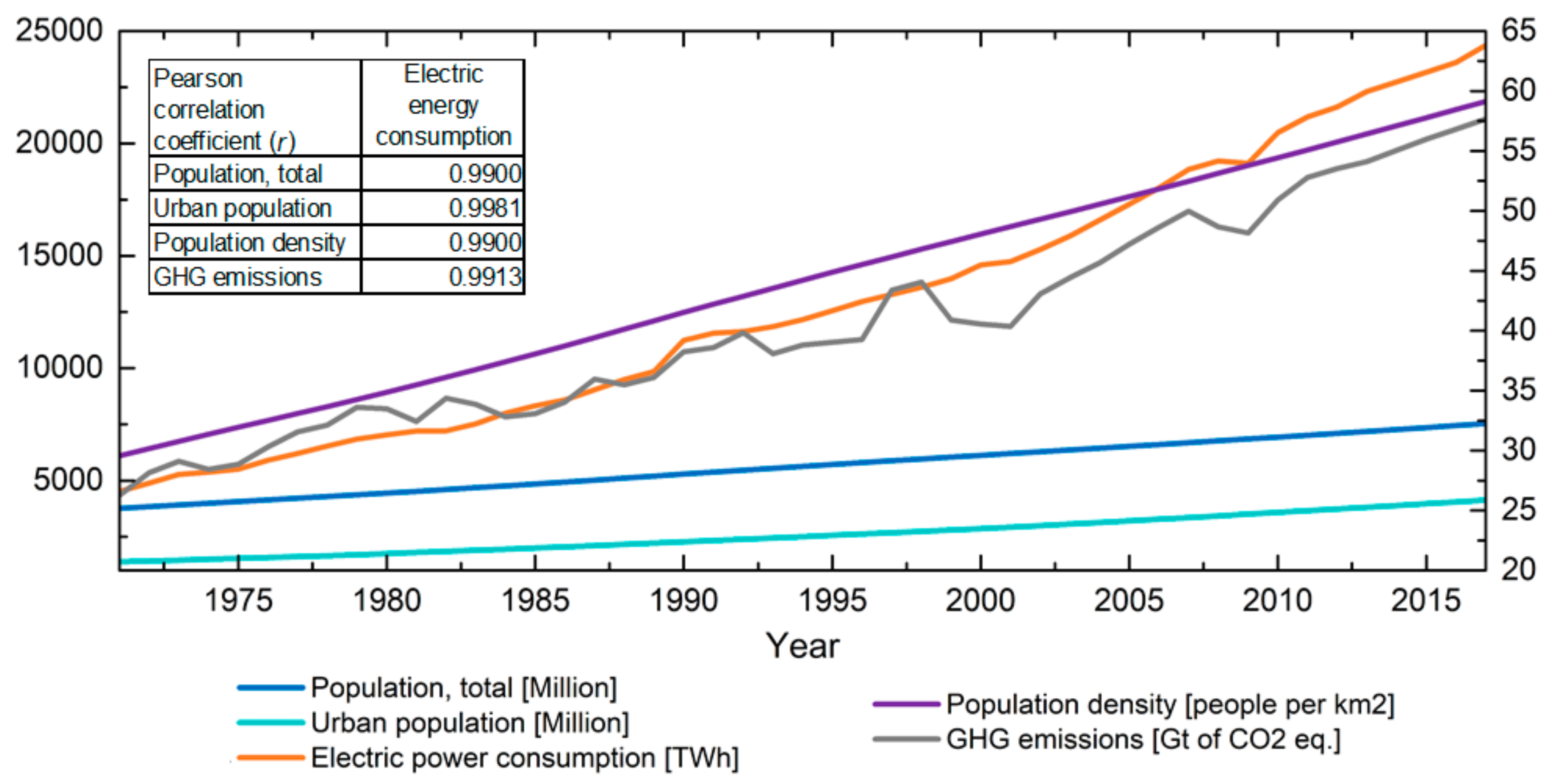
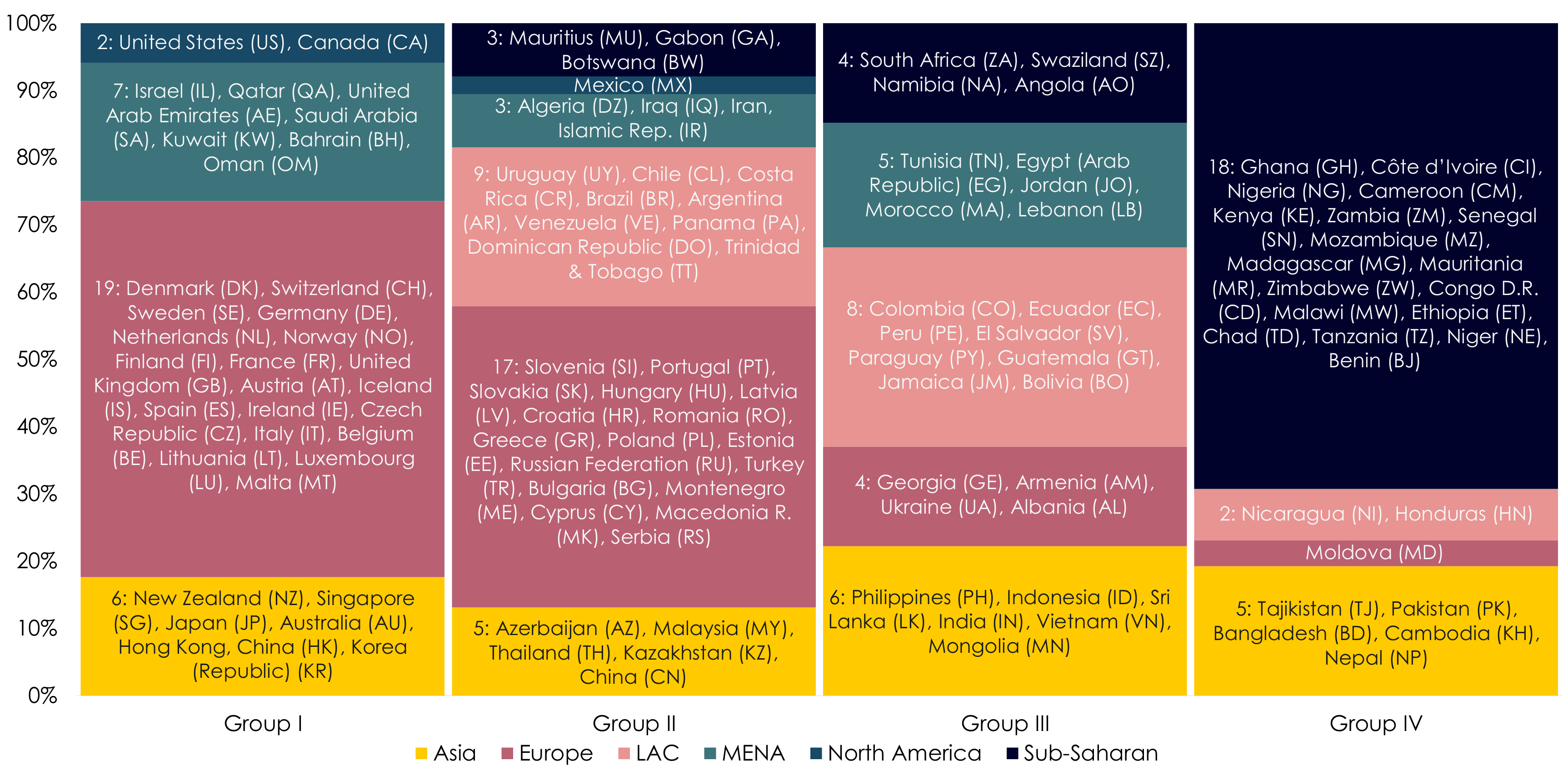
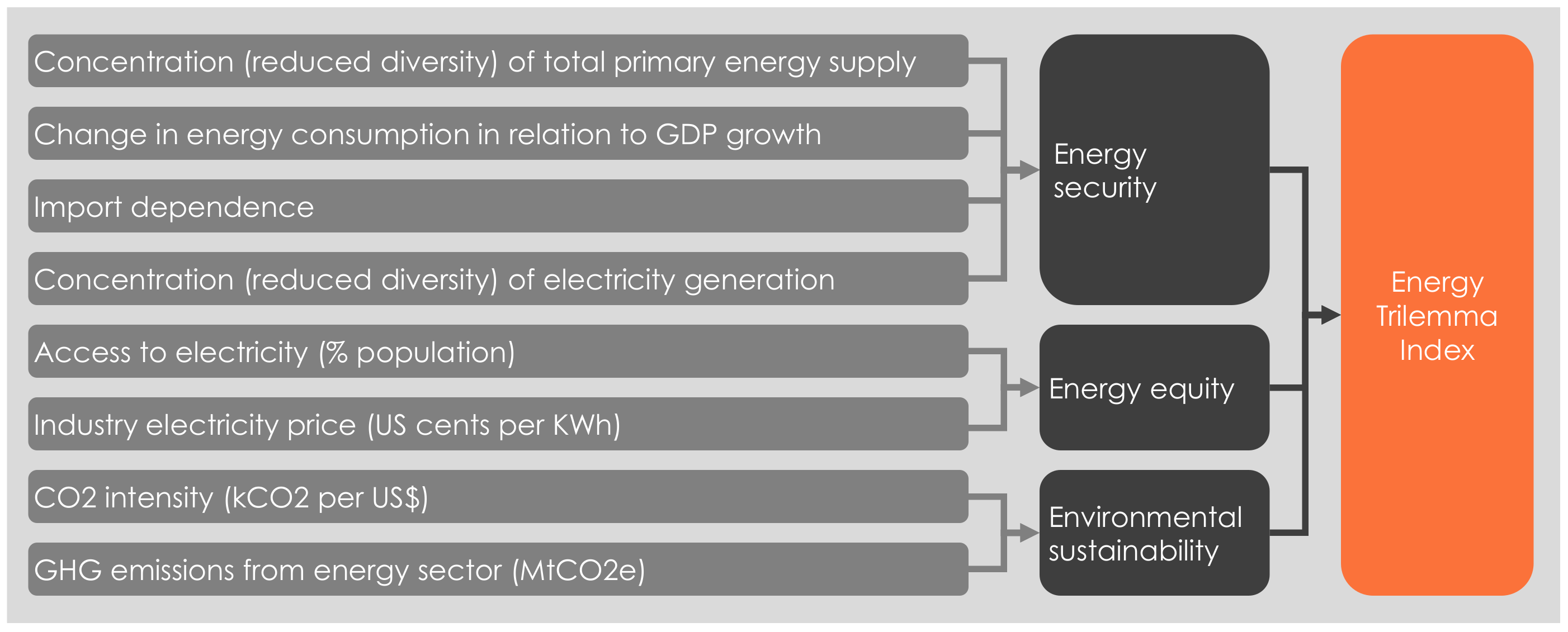
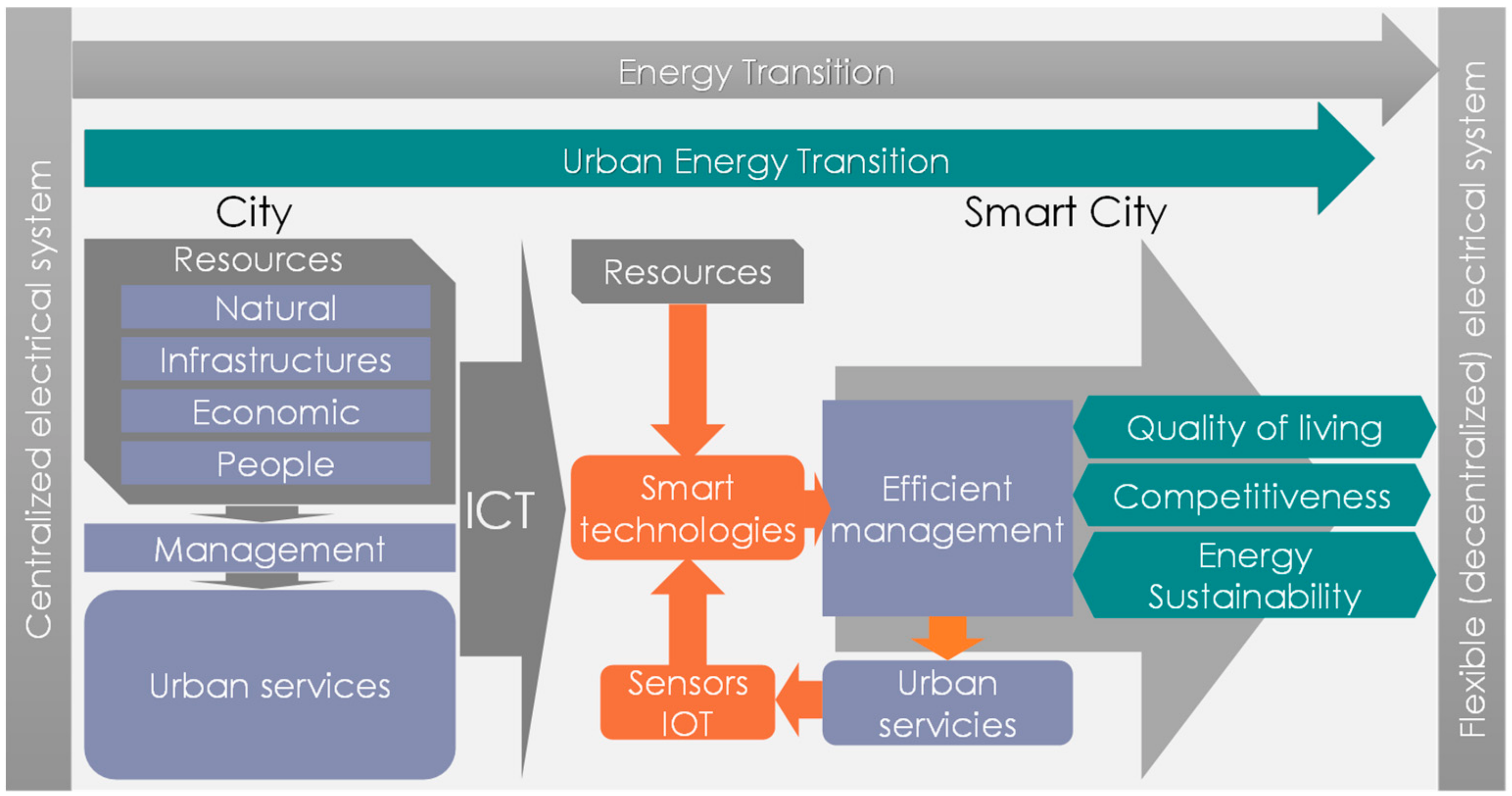
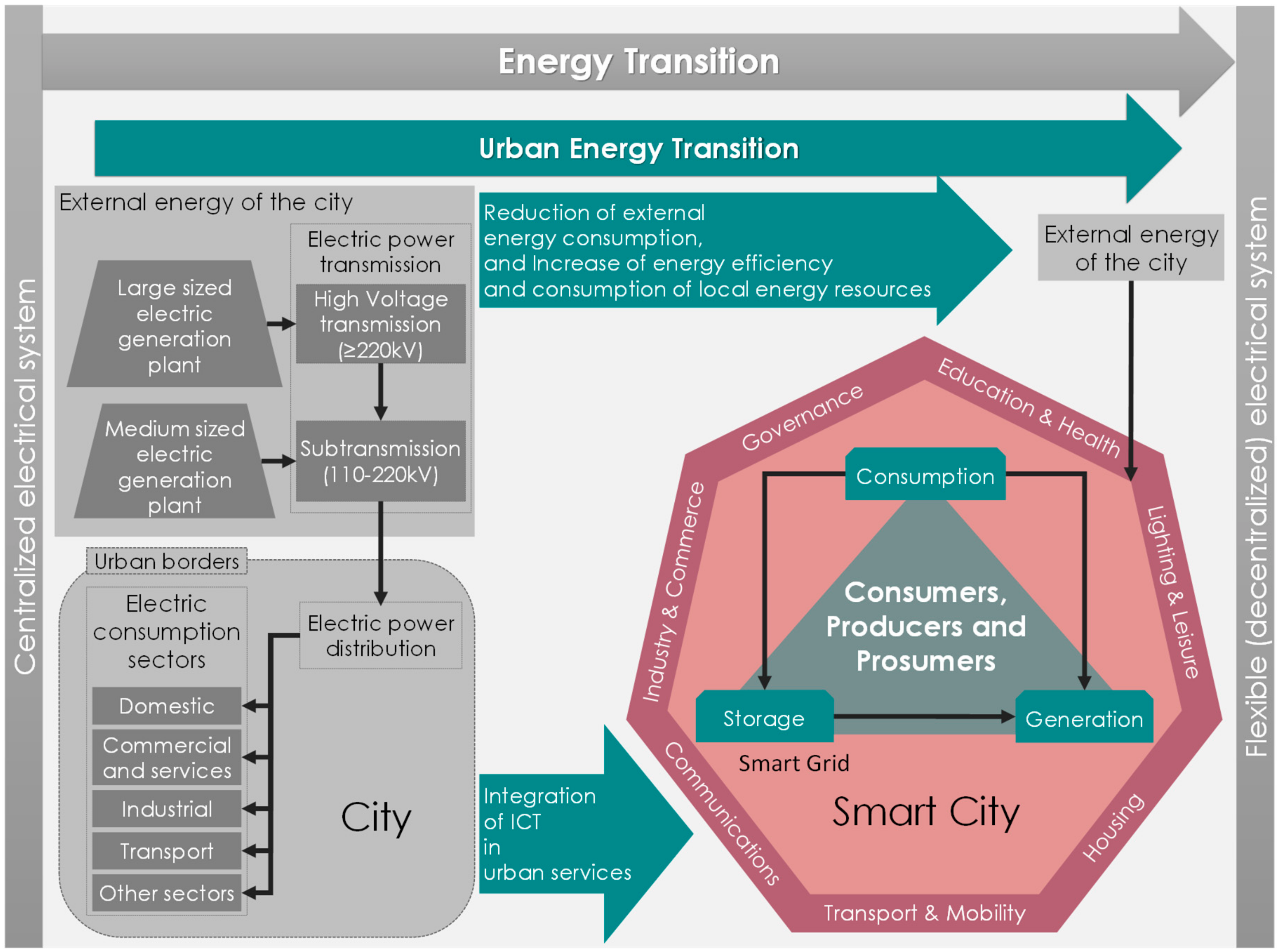
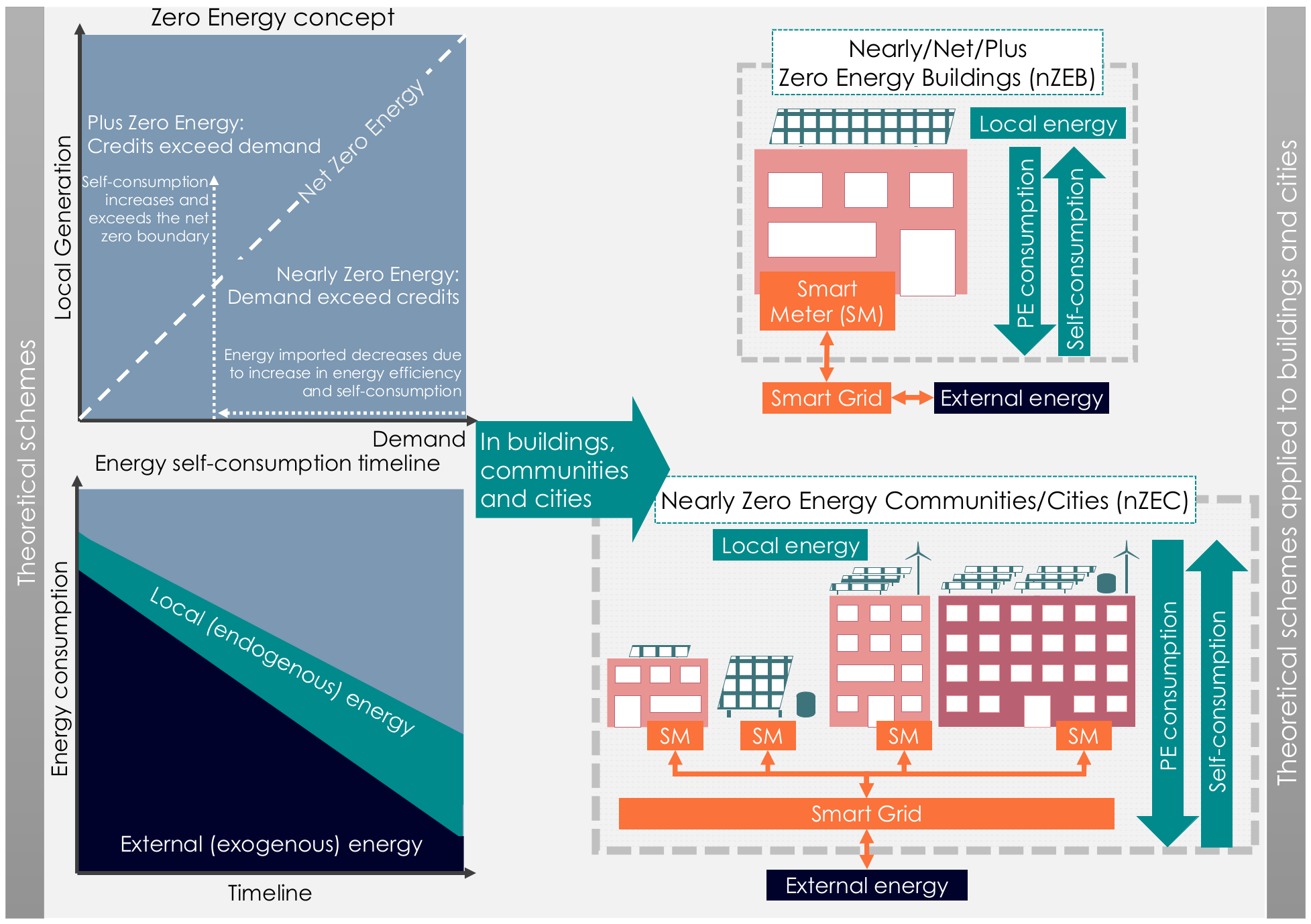
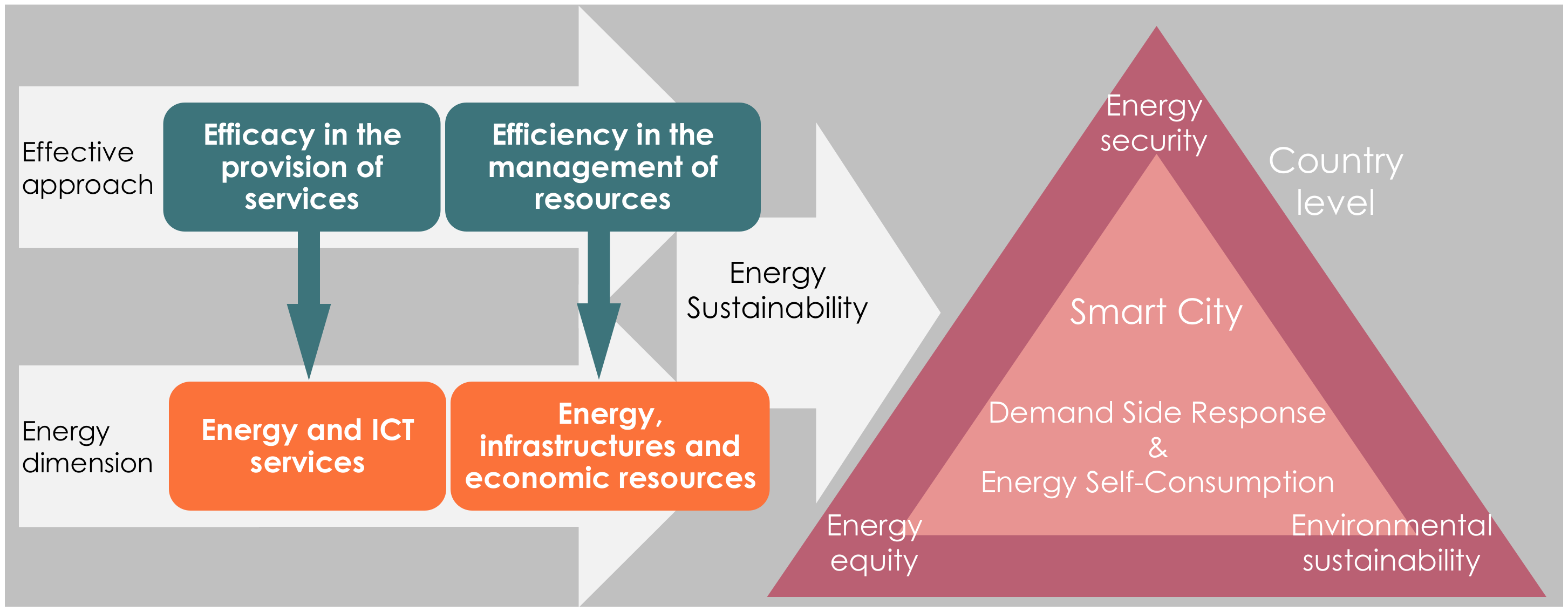
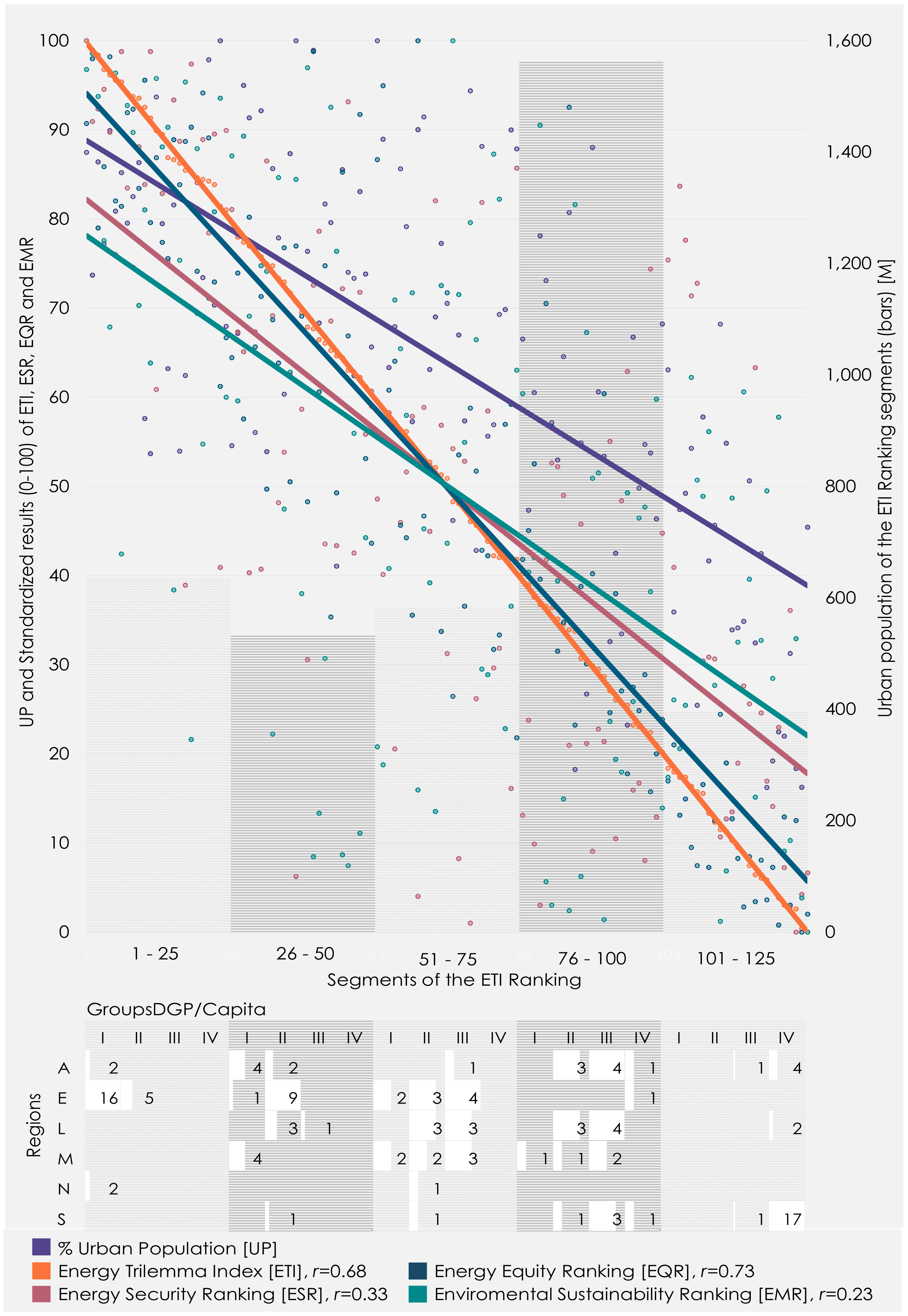
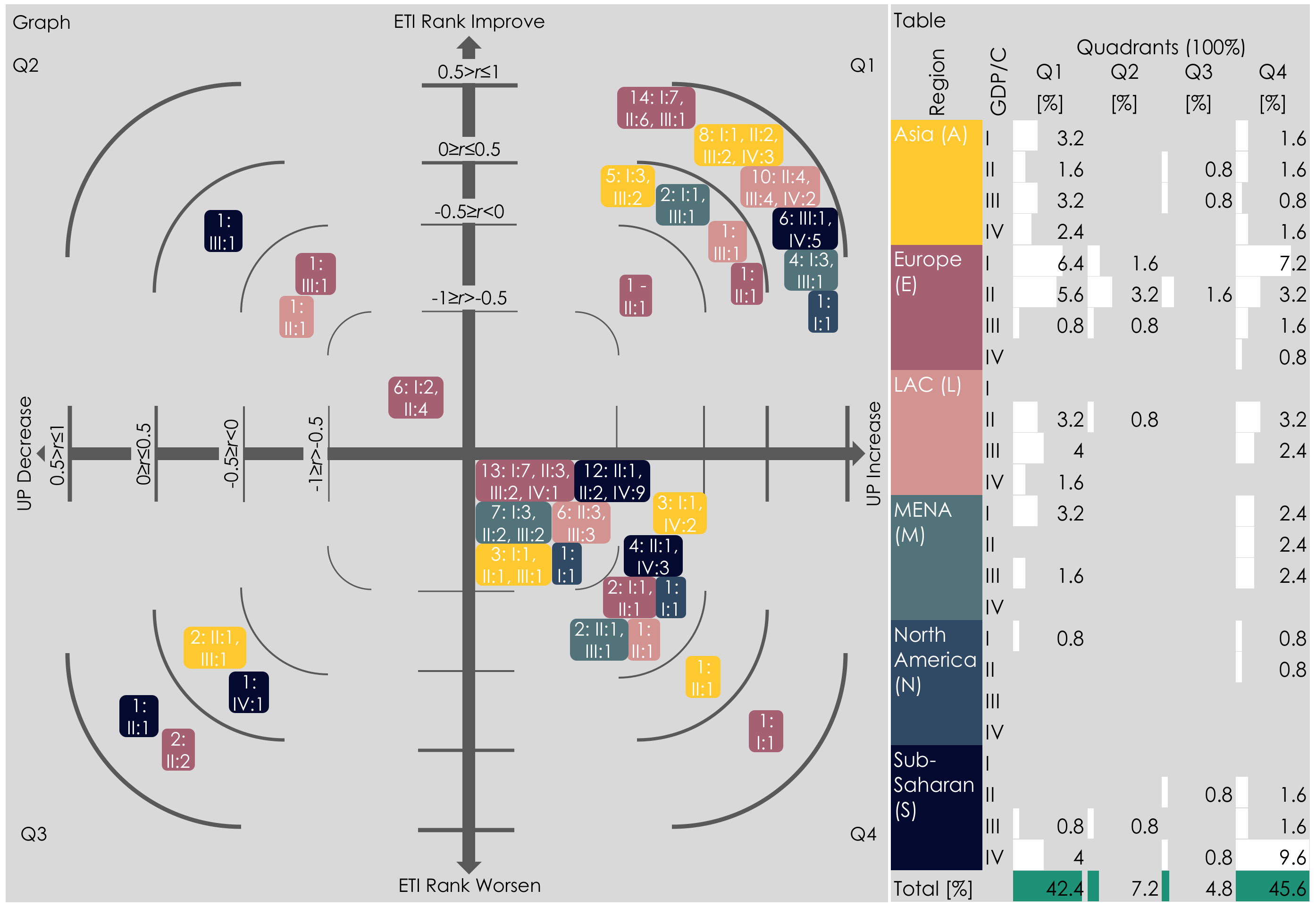
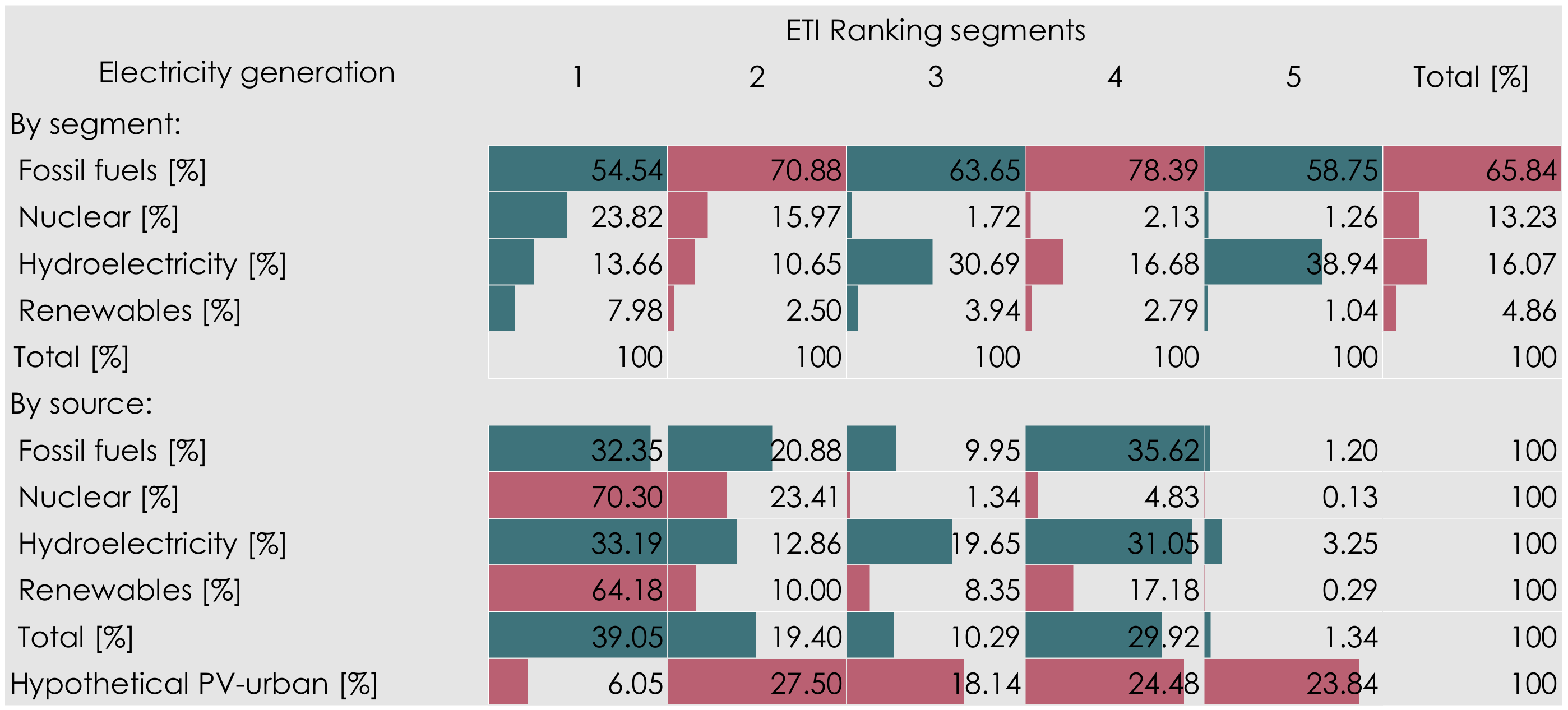
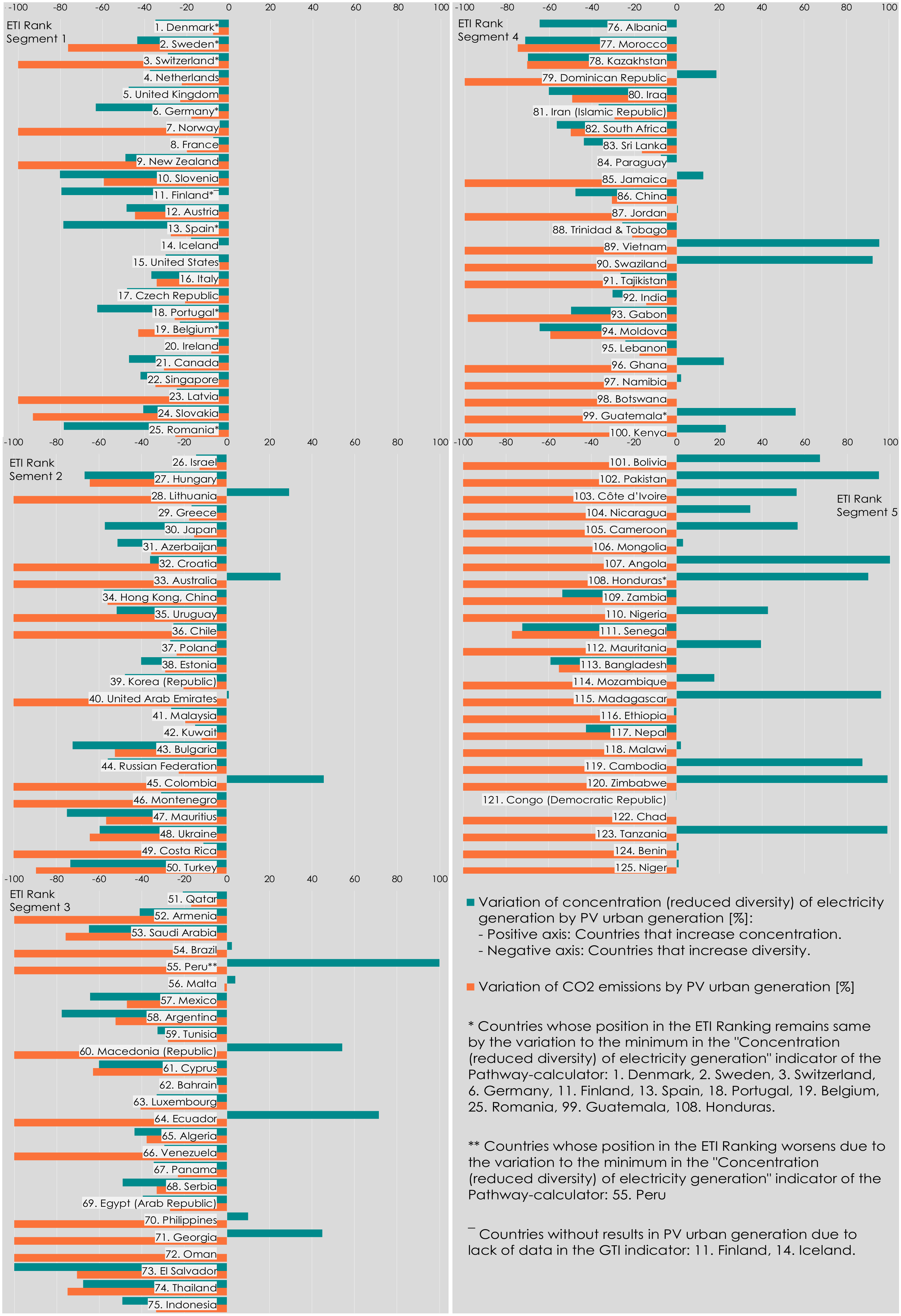
| Variation to the Minimum | Variation to the Maximum | ||||||||
|---|---|---|---|---|---|---|---|---|---|
| Indicator | ETI Ranking Segment | Worst | Same | Best | N/A | Worst | Same | Best | N/A |
| Concentration (reduced diversity) of electricity generation (0–100) * | 1–25 | 0 | 9 | 16 | 0 | 25 | 0 | 0 | 0 |
| 26–50 | 0 | 0 | 25 | 0 | 20 | 5 | 0 | 0 | |
| 51–75 | 1 * | 0 | 24 | 0 | 17 | 8 | 0 | 0 | |
| 76–100 | 0 | 1 | 24 | 0 | 19 | 6 | 0 | 0 | |
| 101–125 | 0 | 1 | 24 | 0 | 16 | 9 | 0 | 0 | |
| Total | 1 | 11 | 113 | 0 | 97 | 28 | 0 | 0 | |
| Concentration (reduced diversity) of total PE supply (0–100) ** | 1–25 | 0 | 6 | 19 | 0 | 25 | 0 | 0 | 0 |
| 26–50 | 0 | 3 | 22 | 0 | 25 | 0 | 0 | 0 | |
| 51–75 | 1 * | 1 | 23 | 0 | 23 | 1 | 1 | 0 | |
| 76–100 | 0 | 1 | 23 | 1 | 21 | 3 | 0 | 1 | |
| 101–125 | 0 | 2 | 19 | 4 | 18 | 3 | 0 | 4 | |
| Total | 1 | 13 | 106 | 5 | 112 | 7 | 1 | 5 | |
| Import dependence (1–100) | 1–25 | 0 | 1 | 24 | 0 | 23 | 1 | 1 | 0 |
| 26–50 | 0 | 0 | 25 | 0 | 22 | 3 | 0 | 0 | |
| 51–75 | 0 | 0 | 25 | 0 | 21 | 2 | 2 | 0 | |
| 76–100 | 0 | 0 | 25 | 0 | 22 | 2 | 1 | 0 | |
| 101–125 | 0 | 0 | 25 | 0 | 21 | 4 | 0 | 0 | |
| Total | 0 | 1 | 124 | 0 | 109 | 12 | 4 | 0 | |
| GHG emissions from energy sector (MtCO2e) (0–10,000) *** | 1–25 | 0 | 7 | 18 | 0 | 25 | 0 | 0 | 0 |
| 26–50 | 0 | 2 | 22 | 1 | 23 | 1 | 0 | 1 | |
| 51–75 | 0 | 0 | 25 | 0 | 24 | 0 | 1 | 0 | |
| 76–100 | 2 ** | 0 | 22 | 1 | 23 | 0 | 1 | 1 | |
| 101–125 | 0 | 1 | 20 | 4 | 17 | 4 | 0 | 4 | |
| Total | 2 | 10 | 107 | 6 | 112 | 5 | 2 | 6 | |
| ETI Ranking Segments | ||||||
|---|---|---|---|---|---|---|
| Total | 1 | 2 | 3 | 4 | 5 | |
| Number of countries analyzed | 125 | 25 | 25 | 25 | 25 | 25 |
| Average concentration (reduced diversity) of electricity generation (0–100) | 66.41 | 44.92 | 65.40 | 71.76 | 76.76 | 73.20 |
| After the urban PV generation (0–100) | 55.16 | 28.23 | 44.98 | 55.53 | 61.37 | 85.71 |
| Average variation | −15.94 | −42.49 | −32.33 | −20.91 | −14.29 | 30.32 |
| Number of countries that have diversity electricity generation | 87 | 25 | 21 | 18 | 16 | 7 |
| Average variation of concentration (reduced diversity) [%] | −42.44 | −42.49 | −43.30 | −45.08 | −42.51 | −32.70 |
| Number of countries that concentrate electricity generation | 38 | 0 | 4 | 7 | 9 | 18 |
| Average variation of concentration (reduced diversity) [%] | 44.73 | 0.00 | 25.25 | 41.25 | 35.90 | 54.83 |
| Average variation of the consumption of fossil fuels [%] | −56.31 | −30.93 | −50.24 | −51.08 | −57.88 | −91.41 |
| Average variation in CO2 emission [%] | −64.00 | −40.72 | −59.62 | −61.09 | −65.29 | −93.29 |
© 2019 by the authors. Licensee MDPI, Basel, Switzerland. This article is an open access article distributed under the terms and conditions of the Creative Commons Attribution (CC BY) license (http://creativecommons.org/licenses/by/4.0/).
Share and Cite
Villa-Arrieta, M.; Sumper, A. Contribution of Smart Cities to the Energy Sustainability of the Binomial between City and Country. Appl. Sci. 2019, 9, 3247. https://doi.org/10.3390/app9163247
Villa-Arrieta M, Sumper A. Contribution of Smart Cities to the Energy Sustainability of the Binomial between City and Country. Applied Sciences. 2019; 9(16):3247. https://doi.org/10.3390/app9163247
Chicago/Turabian StyleVilla-Arrieta, Manuel, and Andreas Sumper. 2019. "Contribution of Smart Cities to the Energy Sustainability of the Binomial between City and Country" Applied Sciences 9, no. 16: 3247. https://doi.org/10.3390/app9163247
APA StyleVilla-Arrieta, M., & Sumper, A. (2019). Contribution of Smart Cities to the Energy Sustainability of the Binomial between City and Country. Applied Sciences, 9(16), 3247. https://doi.org/10.3390/app9163247






